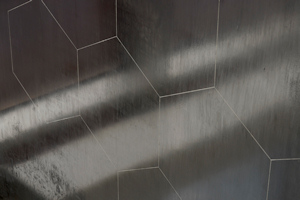Jun 18 2015
A huge graphite wall drawing has been unveiled at The University of Manchester’s new National Graphene Institute.
 The artwork has been carved into the wall of the National Graphene Institute
The artwork has been carved into the wall of the National Graphene Institute
Spanning the three upper floors of the recently opened £61m Institute, the permanent artwork depicts the story of graphite and graphene – its geography, geology and development in the North West of England. Graphene is a form of carbon derived from graphite, and at one-atom-thick it promises to revolutionise the material world.
Nobel laureate Sir Kostya Novoselov personally invited Manchester artist Mary Griffiths to create the drawing. Mary’s work has been shown in exhibitions in Manchester, London, and internationally, and she has works in public and private collections. She is also Curator of Modern and Contemporary Art at the Whitworth in Manchester.
The commission is made possible through support from Arts Council England and The University of Manchester.
Griffiths’ drawing is titled From Seathwaite after the place where graphite was first found in the Lake District. A 13 by two metre area of white plaster has been completely covered with many layers of graphite, making a dense and reflective black surface – a practice Mary has developed over the past seven years.
Three abstract drawings have been cut into the black surface, representing graphite’s origins in the Lake District, its hexagonal structure, and its development at The University of Manchester into graphene. A team of four assistants worked with Mary to make the drawing in one month.
From Seathwaite is both made of graphite and is about the history of the material. Its location is uniquely at the heart of production and research into graphene. The drawing is highly reflective and literally reflects the architecture of the National Graphene Institute (NGI), the people who work in it and the city of Manchester.
Sir Kostya said: “It is impressive to see how much the sometimes tragic history of graphite is linked to North West, starting from the first graphite mines in Windscale Fire to graphene.
“I see Mary’s work as part of this history. But most importantly, her work can serve as a link connecting the episodes in the story still to be written.”
Mary added: “It’s incredibly special and a great honour to have been asked by Sir Kostya Novoselov to make this work of art at the heart of the National Graphene Institute. I’ve been using graphite for many years now and am fascinated by it as a material.
“For the NGI to bring art and science together in this new building is very forward thinking, making it possible for me to make my largest ever drawing. It shows how art and science come from similar imaginative places.”
The NGI is the world’s leading centre of graphene research and commercialisation. Academics and industrial partners will work side by side on developing graphene applications in state-of-the-art laboratories and collaborative space.
It was funded from £38m from the Engineering and Physical Sciences Research Council (EPSRC) and £23m from the European Regional Development Fund (ERDF).
Source: http://www.manchester.ac.uk/